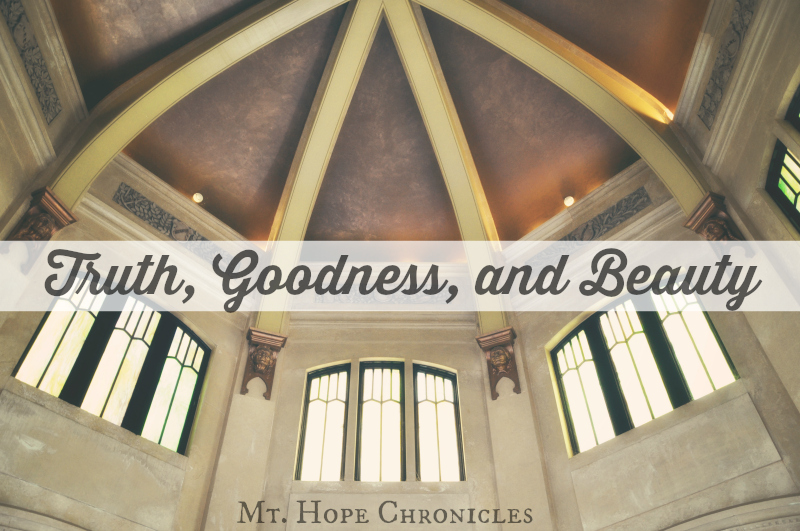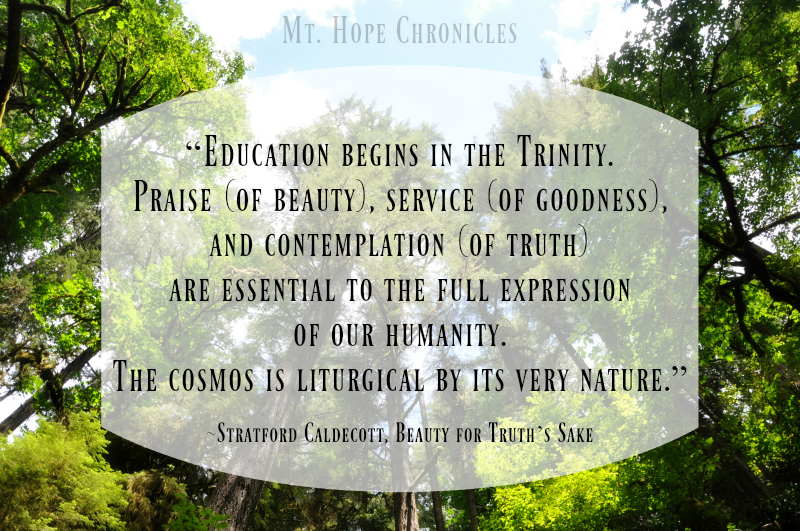
Today, I am practicing Lectio Devina. I am taking what I’m reading and hearing, what I’m contemplating and synthesizing, and sharing it with you.
This series has three parts, because all good thoughts have three parts, right?
We’ll begin with a look at Truth, Goodness, and Beauty. (See? Three!)
For those of you familiar with the Myers Briggs personality types, I am an ISFJ. This means that I’m concrete and sequential, but I’m very emotional about it. [grin]
This also means that I have to digest philosophical ideas in a concrete, practical way. Maybe this is the “caricature” learning, as Andrew Kern calls it. First, the broad and basic outlines, a child’s drawing. Later, the nuances. I’m still in the stick-figure stage.
I am sharing here in humility. Much of what I share with you is what I have organized from excellent thinkers, writers, and speakers. (“I’m a synthesizer, not a generator,” as one of my friends said recently.) Or we can call it curating: select, organize, and present (hey, that’s the three stages of Lectio Devina!). Consider this a peek into my commonplace journal. Or, to state it more correctly, this is my commonplace journal.
The above quote is beautiful, isn’t it? We can let the words wash over us, but I don’t think we can begin to apply them unless we truly contemplate the meaning of the words. When I begin to contemplate, I almost always start with definition.
We will start our series with Truth, Goodness, and Beauty (vision), then move on to Cosmos (form), and then finish with Liturgy (routine and content). This won’t be anything close to an exhaustive contemplation, but merely a jumping off place.
Truth, Goodness, & Beauty: The Vision
Sources:
:: David Hicks (PNW CiRCE Conference)
:: The Wound of Beauty by Gregory Wolfe @ Image Journal as well as my notes from Greg Wolfe’s talk at the PNW CiRCE Conference
Truth, Goodness, and Beauty.
These are our WHY, our principles. Our vision for education.
If you are like me, you’ve heard the words truth, goodness, and beauty often, particularly in the context of defining Classical Education. But what exactly do they mean? What are they? Where did they come from? How do we know them? Why are they important? How do we pursue them?
What are they?
Truth, Goodness, and Beauty transcend our reality, which is why they are known as the transcendentals.
They point to or reflect something beyond our physical reality (God). They don’t explain themselves. They require a first cause, a reason outside of themselves for their existence.
The First Cause Argument by Peter Kreeft
If there is no first cause, then the universe is like a great chain with many links; each link is held up by the link above it, but the whole chain is held up by nothing.
The most famous of all arguments for the existence of God are the "five ways" of Saint Thomas Aquinas. One of the five ways, the fifth, is the argument from design, which we looked at in the last essay. The other four are versions of the first-cause argument, which we explore here.
The argument is basically very simple, natural, intuitive, and commonsensical. We have to become complex and clever in order to doubt or dispute it. It is based on an instinct of mind that we all share: the instinct that says everything needs an explanation. Nothing just is without a reason why it is. Everything that is has some adequate or sufficient reason why it is.
C. S. Lewis put it, "I felt in my bones that this universe does not explain itself."
Greg Wolfe gives us some helpful particulars about truth, goodness, and beauty:
They have qualities of being:
· Truth being knowable.
· Goodness being lovable.
· Beauty being admirable and desirable.
They are equal. A trinity.
· Truth without beauty is propaganda. It is moralism (rather than mystery). It is fleshless abstraction. Only beauty can incarnate truth.
· Goodness without beauty is moralism (a “better than thou” mindset).
· Beauty without truth is a lie and a mask, empty and hollow.
· Beauty without goodness is frigid, lifeless virtuosity. It is form without meaning.
David Hicks connects the transcendentals with the person of Christ:
Christ is the incarnation of the transcendentals, the transcendentals embodied in a person. They are not ideas, laws, or art.
· Christ expresses truth not in precepts but in parables.
· He expresses goodness not in laws but in love.
· He expresses beauty not in majesty but in humility, holiness, obedience.
David Hicks goes on to say that our modern culture has tried to convince us that truth is relative, goodness is situational, and beauty is subjective.
[Awakening Wonder] “We cannot teach our students that Truth is relative and expect our politicians to be honest; we can’t claim that the Good has been replaced by situational ethics and expect our bankers to ground their business decisions in anything other than profit, greed, and expediency; and we cannot relegate Beauty to personal preference and then feign shock when we encounter a urinal as part of an art exhibit.”
Where did they come from?
[Awakening Wonder by Turley, roughly quoted/paraphrased] “The concept of the transcendentals first emerged in the early Greek world, around the 5th century BC, but we don’t find the concepts of truth, goodness, and beauty converged until the writings of Plato around 400 BC in what has been termed the ‘Socratic trinity’ or ‘Platonic triad.’ The first clear presentation of truth, goodness, and beauty comes from a 15th century commentary on Plato’s writings by an Italian scholar. For Plato, they were divine concepts, and he believed that the individual human can mirror, reflect, or image the virtues of the transcendentals and thereby participate in divine life. It is philosophia, the love of wisdom, that seeks to recover human perception of truth, goodness, and beauty so as to restore the human soul to its participation in divine life.”
“The Christian tradition (notably expressed by Augustine and Aquinas) asserts that truth, goodness, and beauty are divine attributes by which the whole of creation is endowed with meaning and purpose, and focused particularly in microcosmic form in the distinctly human manifestation of the image of God… and that all that is true, beautiful, and good finds its fulfillment in Jesus Christ.”
Why are they important?
[Awakening Wonder] “By encountering Truth, the human intellect is awakened to the infinite wisdom of God revealed in Christ; by encountering Goodness, the human volition is directed to act in accordance with the divine purposefulness of creation and our own created nature renewed in Christ; and by encountering Beauty, the human soul is awakened to the inexhaustible wellspring of diving love revealed in Christ. In short, the Christian vision of Truth, Goodness, and Beauty is an invitation, a divine call, to awaken the fullness of our humanity as the entire cosmos is incorporated into the transformative life, death, and resurrection of Christ.”
How do we know them?
Greg Wolfe says that we use human faculties to know them:
· The faculty by which we perceive or apprehend truth is reason.
· The faculty by which we perceive or apprehend goodness is faith or holiness.
· The faculty by which we perceive or apprehend beauty is imagination.
A faculty is an inherent mental or physical power.
Imagination is the faculty or action of forming new ideas, or images or concepts of external objects not present to the senses. Essentially, it is the ability to “picture to oneself.”
How do we pursue them?
So anything that helps us develop our faculties of reason, faith, and/or imagination serves us in our pursuit of truth, goodness, and beauty.
We actively praise (beauty), serve (goodness), and contemplate (truth).
And, in imitation of Christ, we seek parables (truth), love (goodness), humility/holiness/obedience (beauty).
This is where our model of education begins.


"· The faculty by which we perceive or apprehend truth is reason.
ReplyDelete· The faculty by which we perceive or apprehend goodness is faith or holiness.
· The faculty by which we perceive or apprehend beauty is imagination. "
--
I keep running into people who mix these, for instance seeking truth through imagination. For sake of argument (with myself for clarity) I'm mixing the others similarly, but affirming they cannot be interchangeable. Am I wrong? It seems truth is considered so subjectively these days. perhaps I am just focused on that.
The ideas shared in this post are so excellent and so noteworthy.